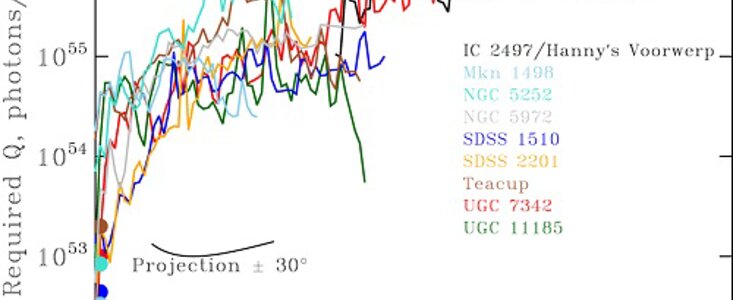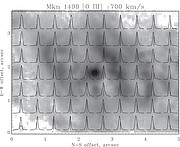Gemini Explores Fading Active Galactic Nuclei ID'd by Galaxy Zoo
7 February 2017
Gemini follows up on candidate galaxies with fading active galactic nuclei (AGN) first identified thanks to the Galaxy Zoo citizen science project. Researchers find that these galaxies show a significant reduction in ionizing photons within the last 20,000 years. Additionally, the gas clouds around these fading AGN are dominated by rotation, unlike those around radio-loud AGN, which are outflows coming from the nuclei.
William C. Keel (University of Alabama) and his collaborators used Hα narrowband filters on the Hubble Space Telescope (HST) in conjunction with multi-object spectroscopy with the Gemini Multi-Object Spectrograph (GMOS) integral-field unit (IFU) on the Gemini North telescope on Maunakea to observe a set of fading active galactic nuclei (AGN). These fading AGN, identified in the Galaxy Zoo project, appear to have experienced a significant reduction in luminosity within 20,000 years or less based on this research.
This work focused on nine AGN which are accompanied by extended ionized gas clouds larger than 10 kiloparsecs from these galaxies’ nuclei. Because these clouds span galaxy scales (or even larger) they can implicitly tell us about the luminosity history of the AGN. A common feature in this subset of AGN is a radial drop in luminosity within 20,000 year timeframes which can be observed in Figure 1, where rapid drops in the number of ionizing photons is shown.
The research team also used the GMOS IFU spectra to measure line ratios in these regions to probe their ionization mechanism and look for kinematic evidence of outflows – marked by large velocity ranges and often bipolar patterns in velocity – or other phenomena.
The team's results confirm what was hinted at by earlier, and less complete data (by the same team), that these fading AGN are structurally different from radio-loud AGN which are dominated by outflows. Instead, these fading AGN are dominated by rotation and consist largely of externally illuminated tidal debris. The rotation can be observed in Figure 2, based on Gemini data which shows shifting of the [O III] emission line due to rotation of the gas cloud.
In summary, these results support the idea that AGN with extended emission regions are bright for periods 10,000-100,000 years, interspersed with substantially fainter episodes. Further work by the group will examine the ionization of circumnuclear gas, where direct AGN radiation may no longer be the most important source, and more detailed modeling of the gas motions in these galaxies.
Paper Abstract
We consider the energy budgets and radiative history of eight fading AGN, identified from an energy shortfall between the requirements to ionize very extended (radius > 10 kpc) ionized clouds and the luminosity of the nucleus as we view it directly. All show evidence of significant fading on ~50,000-year timescales. We explore the use of minimum ionizing luminosity Qion derived from photoionization balance in the brightest pixels in Hα at each projected radius. Tests using presumably constant Palomar-Green (PG) QSOs, and one of our targets with detailed photoionization modeling, suggest that we can derive useful histories of individual AGN, with the caveat that the minimum ionizing luminosity is always an underestimate and subject to uncertainties about ne structure in the ionized material. These consistency tests suggest that the degree of underestimation from the upper envelope of reconstructed Qion values is roughly constant for a given object and therefore does not prevent such derivation. The AGN in our sample show a range of behaviors, with rapid drops and standstills; the common feature is a rapid drop in the last 2 x 104 years before the direct view of the nucleus. The e-folding timescales for ionizing luminosity are mostly in the thousands of years, with a few episodes as short as 400 years. In the limit of largely obscured AGN, we find additional evidence for fading from the shortfall between even the lower limits from recombination balance and the maximum luminosities derived from infrared fluxes. We compare these long-term light curves, and the occurrence of these fading objects among all optically identified AGN, to simulations of AGN accretion; the strongest variations on these timespans are seen in models with strong and local (parsec-scale) feedback. We present Gemini integral-field optical spectroscopy, which shows a very limited role for outflows in these ionized structures. While rings and loops of emission, morphologically suggestive of outflow, are common, their kinematic structure shows some to be in regular rotation. UGC 7342 exhibits local signatures of outflows < 300 km/sec, largely associated with very diffuse emission, and possibly entraining gas in one of the clouds seen in HST images. Only in the Teacup AGN do we see outflow signatures of order 1000 km/sec. In contrast to the extended emission regions around many radio-loud AGN, the clouds around these fading AGN consist largely of tidal debris being externally illuminated but not displaced by AGN outflows.
Links
- This work is accepted in The Astrophysical Journal and the paper can be found here.
- Also read this Galaxy Zoo blog posting describing this work.



